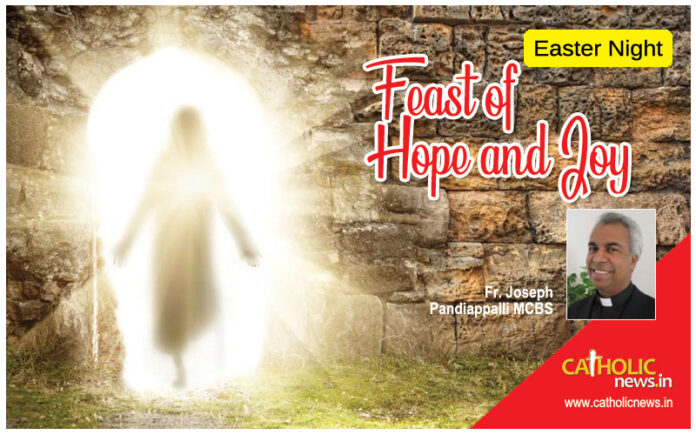
Mary Magdalene is mentioned as a witness to the resurrection of Jesus in the Gospels of Matthew, Mark, Luke, and John although she had not seen the event of Jesus‘ resurrection. She was first informed of the resurrection. We heard today from the Gospel of Luke that Mary Magdalene, Joanna, and Mary, the mother of James, and the other women told the apostles what they had heard from the angels of God at Jesus’ tomb: “Jesus is not here; he has risen.” In the Gospel of Mark, another woman is mentioned, named Salome.
When the Evangelist Luke writes: “and the other women,” it means that it was a group of women who went to the tomb of Jesus to pay their last respects. When these women heard, “He is not here, he has risen,” they remembered what Jesus had said in Galilee: The Son of Man must be crucified and rise again on the third day. They quickly understood the connection between the prediction and the reality. They could understand that the prediction was realised. So they set out to meet the apostles who were the future leaders of the community of disciples.
But when the women met the apostles and shared their experience at the tomb full of joy and enthusiasm the apostles considered it nonsense and did not believe them. It means that the apostles did not take the very important message seriously.
But there were one or two who reflected over it and wanted to verify. Peter was willing to go to the tomb to check whether Jesus’ body was still there. When the soldiers took money and told them, “While we were sleeping, his disciples came in the night and stole him,” one or another of Jesus’ apostles must have wondered thinking who could have taken Jesus’ body in the night.
And Mary Magdalene and other women who communicated the message of resurrection must have said to each other at the time, “We know exactly, but these men don’t believe us.”
Not only that, the evangelist Luke reports another event in another part of the same chapter. As Jesus appeared to his apostles, they were discussing their encounter with the Risen Jesus among their colleagues, believing that the apparition had been a ghost. That means many of the apostles could not believe the resurrection of Jesus as it was reported by their colleagues and the women. But when the apostles were finally convinced by Jesus’ appeared to them personally. This personal encounter of the risen Lord and the repeated appearances convinced them. With enthusiasm and joy, they wanted to spread the message of the risen Lord. One of them said: “No, I won’t believe it unless I can see the nail marks in his hands and place my finger in the nail marks and my hand in his side.” Jesus still had to personally convince the apostle Thomas so that the college of apostles could stand together and proclaim the Good News together.
What Mary Magdalene, Mary the mother of James, Salome, and the group of other women immediately recognized and passed on with conviction, enthusiasm, and joy, just like the closest circle of disciples, even without a personal encounter with Jesus, as it is written in the Gospel of Luke, the apostles took a long time to realize: Jesus had to appear to them personally several times, even eat fish and bread with them, even grant Thomas a special audience and invite him to place his hands in his side.
Through the Scriptures, we have an idea of how slowly and gradually the apostles were convinced at that time, how difficult it was for them to make a common statement and to proclaim the great joyful news predicted by Jesus. It was the most important news after the death of Jesus, as the apostle Paul says: “But if Christ has not been raised, then our preaching is empty and your faith is useless” (1 Cor. 15:14).
But after this desperate phase of fear, excitement, and tension, all the apostles, male and female disciples, Mary Magdalene, Mary the mother of James, Salome, and the other women, proclaimed the message together with great joy. Peter preached. “God has raised this Jesus, and we are all witnesses.” Just as the angels said at the birth of Jesus, “I bring you good news of great joy that will be for all the people,” so Jesus’ first disciples proclaimed the good news of Jesus’ resurrection with great joy.
Saint Augustine writes of the Easter Vigil: ”
What joy, sisters and brothers!
Joy to be gathered here,
Joy to sing psalms and hymns,
Joy to remember the Passion and Resurrection of Christ,
Joy to hope for the life to come.”
The Feast of the Resurrection reminds me not only of who recognized the truth first, quickly, and immediately, but also how cautiously and carefully we can gradually convince everyone of the truth, whether it be the joy of the resurrection, issues relating to the church, the congregation, or individuals in the family. The Feast of the Resurrection reminds me how important it is for the college of apostles, or for us as a church, congregation, or individual family, to stand together for the truth, and how we can draw joy and hope from our shared experience of faith and solidarity with one another.
The feast of the Resurrection also reminds me of the reality that we should not only think of earthly life, but of a new life after death in hope and joy. We can perhaps achieve this confidence if we plan our lives with joy and hope and shape them accordingly.
Happy Easter.
Fr. Joseph Pandiappallil MCBS



